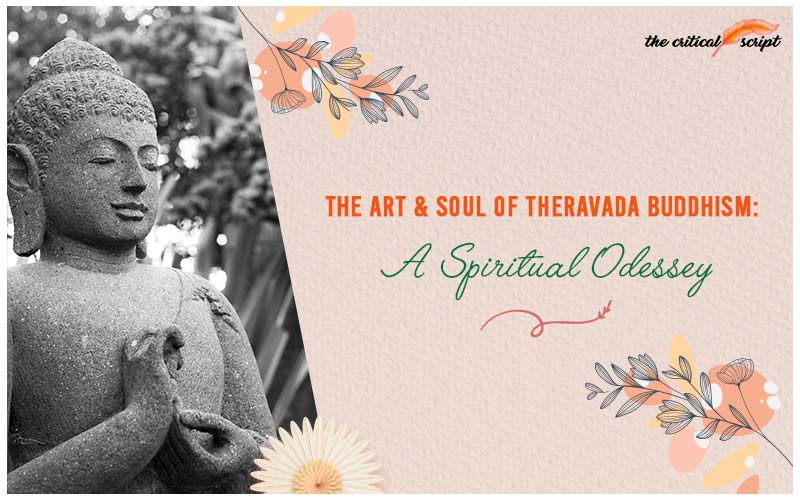
The Art & Soul of Theravada Buddhism: A Spiritual Odessey
India,
often hailed as the “Land of Diversity,” is a vibrant tapestry woven with a
multitude of cultures, traditions, languages, and religions. From the ancient
practices of Hinduism and Jainism to the rich traditions of Islam and Christianity, the country's cultural landscape
is both complex and fascinating.
However, did you know that India's northeastern region shares much more than just geographical proximity with Southeast Asia?
Beyond its diverse traditions, this region mirrors Southeast Asia in its social structures, art forms, dance, culinary practices, and even hunting methods. Another notable and intriguing shared element between NorthEast India and Southeast Asia is — the practice of Buddhism. Today, a total of 0.7% of India's population adheres to Buddhism signifying the deep historical roots the religion holds within the country.
Among the various forms of Buddhism, the commonality is particularly evident in the prominence of Theravada Buddhism, in both the regions.
Theravada Buddhism, meaning “the way of the elders,” is regarded as the most authoritative branch of Buddhism, with teachings that are believed to have been passed down directly from the historical Buddha.
The Ten Paramis: A Chain of Virtues
The foundation of Theravada Buddhism rests on the Pali Canon, a collection of scriptures preserved in Pali—a language seen as closest to what the Buddha originally spoke.
Central to Theravada practice, the path to enlightenment is characterized by the cultivation of ten perfections, or Paramis, which guide practitioners in their spiritual development.
The Perfection of Dana (Donation) emphasizes the spirit of giving and sharing, encouraging individuals to cultivate generosity and selflessness. The Perfection of Sila (Ethical Conduct) focuses on upholding moral discipline and virtue, ensuring that one’s actions align with ethical standards. The Perfection of Nekkhamma (Renunciation) involves letting go of worldly attachments and desires, fostering a sense of detachment and inner freedom. Perfection of Panna (Wisom) is about gaining deep insight into the nature of reality and understanding the impermanence and interdependence of all things. Perfection of Viriya (Energy) signifies the application of diligent effort and perseverance in the pursuit of spiritual goals. The Perfection of Khanti (Patience) highlights the importance of tolerance and endurance when facing life's challenges, while the Perfection of Sacca (Truthfulness) demands honesty and integrity in all aspects of life. The Perfection of Adhitthana (Resolution) is about demonstrating steadfast determination and commitment to the path, ensuring that one remains focused and resolute. The Perfection of Metta (Loving-kindness) involves fostering compassion and goodwill towards all beings, promoting a sense of universal love and care. Lastly, the Perfection of Upekkha (Equanimity) emphasizes the cultivation of mental calm and balance, enabling practitioners to maintain stability amidst life's fluctuations.
Together, these perfections form a comprehensive framework for personal and spiritual growth, guiding practitioners toward the ultimate goal of enlightenment.
Bedrock of Principles: Perfection of Dana (Donation)
Among the Ten Paramis, the perfection of donation, or Dana, stands out as the mainspring of Theravada Buddhism. This virtue is foundational because it underpins and enriches all other qualities, laying the groundwork for a life of virtue and wisdom.
In
Buddhism, the essence of Dana lies in the intention behind the
act—giving selflessly and with compassion, regardless of the form it takes.
By
embracing Dana, practitioners transcend personal
attachments and material desires, fostering a profound sense of
interconnectedness and selflessness. In essence, Dana embodies the transformative power
of selflessness, driving individuals towards greater spiritual maturity and
aligning them more closely with the ultimate pursuit of enlightenment.
The Cornerstone of Pali Canon - Sutta Pitaka
At
the heart of Theravada practice is the Sutta Pitaka (basket of discourses) which is one of the three primary scriptures
alongside the Vinaya Pitaka (basket of discipline) and the Abhidhamma Pitaka (basket of higher doctrine) of Theravada Buddhism.
Divided
into four main sections known as Nikayas, the Sutta Pitaka is crucial for understanding the
original teachings of the Buddha. For practitioners, it serves as a
guide to ethical living and mental development, while for scholars, it offers a
rich source of historical and doctrinal study.
Divided into four main sections known as Nikayas, the Sutta Pitaka is crucial for understanding the original teachings of the Buddha. For practitioners, it serves as a guide to ethical living and mental development, while for scholars, it offers a rich source of historical and doctrinal study.
Ancient Legend of Wisdom: The Jataka Tales
All
of these concepts, principles and philosophy are vividly illustrated through
the - Jataka Tales, a collection of ancient Buddhist
literature that recounts the past lives of Siddhartha Gautama, who would later become the Buddha.
Each tale unfolds an episode from one of the Buddha's previous incarnations, where he demonstrated virtues such as compassion, generosity, and wisdom. These chronicles not only entertain but also serve as moral guides, illustrating the importance of ethical behaviour and the impact of selfless actions on one's spiritual journey.
For example, one Jataka Tales tells of a past life where the Buddha was born as a noble king who, despite his wealth and power, chose to live a life of simplicity and service. In one story, he gave away his kingdom to help others in need, demonstrating the highest form of generosity. Another tale recounts how he sacrificed his own life to save a group of animals from a hunter, highlighting the value of compassion and selflessness.
Through these stories, the Jataka Tales emphasize that true generosity transcends material wealth and can be expressed through various forms of giving, such as time, effort, and kindness.
They inspire us to cultivate virtues like patience and compassion, showing that our actions, no matter how small, contribute to our spiritual growth and the well-being of others. By reflecting on these tales, we can better understand and embrace the principles of Dana, enriching our own lives and fostering a more compassionate world.
Sacred Architecture: Art of Theravada Prayer Halls in Arunachal Pradesh
Theravada Buddhism entered NorthEast India along with the Burmese Buddhist
groups who are now settled in the region of Assam and Arunachal Pradesh. The Tai Khamtis, residing primarily in these states, are the principal
adherents of Theravada Buddhism who trace their lineage back to Burma.
In Theravada Buddhism, prayer halls are not just spiritual centres but also
architectural marvels that reflect the deep reverence for the Buddha's teachings.
Traditionally these halls
were built in the structure of a chang, an elevated house made of wooden planks
and bamboo canes supported by wooden or concrete pillars. However, in recent
years, the Reinforced Cement Construction (RCC) technique has gained popularity
across the state offering advantages such as – demonstrating the devotion of
the community in providing enduring and high-quality facilities for the Monastery.
The architectural evolution
of these prayer halls is complemented by their rich decorative traditions. The
walls and ceilings are adorned with intricate floral and geometric patterns
that set a serene backdrop for spiritual activities. Paintings of the Jataka Tales, depicting the previous lives of the Buddha, are framed and displayed against these motifs, creating
a vivid narrative of the Buddha's path to enlightenment along with paintings of the Bodhi Tree, celestial beings, and natural scenery decorated in the
background of the Buddha, sculptures.

In wrapping up our journey
of Theravada Buddhism and its significance in NorthEast India, it's clear that this ancient tradition is more than just
a religious practice—it's a vibrant, living cultural heritage that weaves
together spirituality, community, and art.
In Theravada Buddhism, prayer halls are not just spiritual centres but also architectural marvels that reflect the deep reverence for the Buddha's teachings.
Traditionally these halls were built in the structure of a chang, an elevated house made of wooden planks and bamboo canes supported by wooden or concrete pillars. However, in recent years, the Reinforced Cement Construction (RCC) technique has gained popularity across the state offering advantages such as – demonstrating the devotion of the community in providing enduring and high-quality facilities for the Monastery.
The architectural evolution of these prayer halls is complemented by their rich decorative traditions. The walls and ceilings are adorned with intricate floral and geometric patterns that set a serene backdrop for spiritual activities. Paintings of the Jataka Tales, depicting the previous lives of the Buddha, are framed and displayed against these motifs, creating a vivid narrative of the Buddha's path to enlightenment along with paintings of the Bodhi Tree, celestial beings, and natural scenery decorated in the background of the Buddha, sculptures.
Disclaimer: The opinions expressed in this article are those of the author's. They do not purport to reflect the opinions or views of The Critical Script or its editor.

Newsletter!!!
Subscribe to our weekly Newsletter and stay tuned.

















Related Comments